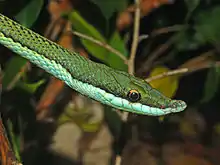Philodryas baroni
Philodryas baroni, common name Baron's green racer,[1] is a species of venomous snake in the family Colubridae. The species is endemic to South America.
| Philodryas baroni | |
|---|---|
 | |
| Philodryas baroni | |
| Scientific classification | |
| Kingdom: | Animalia |
| Phylum: | Chordata |
| Class: | Reptilia |
| Order: | Squamata |
| Suborder: | Serpentes |
| Family: | Colubridae |
| Genus: | Philodryas |
| Species: | P. baroni |
| Binomial name | |
| Philodryas baroni Berg, 1895 | |
| Synonyms[1] | |
| |
Etymology
The Latin specific name, baroni, honors Manuel Barón Morlat, who collected the first specimens.[2][3]
Description
Philodryas baroni can reach a total length (including tail) of about 150–180 centimetres (59–71 in).[4] The males are smaller than the females. The length of the tail is about 30% of the total body length. This species is the longest known in the genus Philodryas. The head is small and elongated, with an extension of the rostral scale, forming a small flexible nasal protuberance more developed in males. The coloration of the body is rather variable.[5] Usually it is green, but there are found specimens tending to blue or brown. The pattern can be uniform or with black longitudinal stripes on the back and on the sides, on the anterior third of the body. The ventral area under the black lateral lines can be white or yellowish-white, sometimes with shades of green or blue.[5]
Behavior
Philodryas baroni is a strictly arboreal snake, with an intense activity during the day. It is generally non-aggressive.[4] If it is frightened, it emits a foul-smelling substance from the cloaca.[4]
Diet
P. baroni feeds on small mice, small lizards, and amphibians.
Venom
P. baroni is opisthoglyphous, i.e., equipped with rear fangs.[4][5] It is venomous and should be treated with caution. A recent characterization of the venom of this species has shown that it has proteolytic activity, being able to inhibit platelet aggregation induced by collagen and thrombin formation. An intradermal injection in mice results in hemorrhage. When injected by the intramuscular route, it induces local effects such as hemorrhage, myonecrosis, edema and leukocyte infiltration, with a minimum hemorrhagic dose of 13.9 μg. Therefore, P. baroni must be considered dangerous to the human.[6]
Habitat
P. baroni lives in forests and savannah woodlands.[4]
Reproduction
P. baroni is oviparous.
References
- "Philodryas baroni ". The Reptile Database. www.reptile-database.org.
- Beolens, Bo; Watkins, Michael; Grayson, Michael (2011). The Eponym Dictionary of Reptiles. Baltimore: Johns Hopkins University Press. xiii + 296 pp. ISBN 978-1-4214-0135-5. (Philodryas baroni, p. 17).
- Berg C (1895). "Dos reptiles neuvos descritos ". Anales del Museo Nacional de Buenos Aires 4: 189-194. (Philodryas baroni, new species, pp. 189-191, Figure 1). (in Latin and Spanish).
- "Philodryas baroni ". Squamata.it.
- Philodryas Archived 2013-12-02 at the Wayback Machine
- Sánchez, M. N.; Timoniuk, A.; Maruñak, S.; Teibler, P.; Acosta, O.; Peichoto, M. E. (January 2014). "Biochemical and biological analysis of Philodryas baroni (Baron's green racer; Dipsadidae) venom: relevance to the findings of human risk assessment". Human & Experimental Toxicology. 33 (1): 22–31. doi:10.1177/0960327113493302. ISSN 1477-0903. PMID 23800999.
External links
| Wikimedia Commons has media related to Philodryas baroni. |
Further reading
- Boulenger GA (1896). Catalogue of the Snakes in the British Museum (Natural History). Volume III., Containing the Colubridæ (Opisthoglyphæ and Proteroglyphæ) ... London: Trustees of the British Museum (Natural History). (Taylor and Francis, printers). xiv + 727 pp. + Plates I-XXV. (Philodryas baroni, p. 136).
- Freiberg M (1982). Snakes of South America. Hong Kong: T.F.H. Publications. 189 pp. ISBN 0-87666-912-7. (Philodryas baroni, p. 137 + four photographs on pp. 142–143).